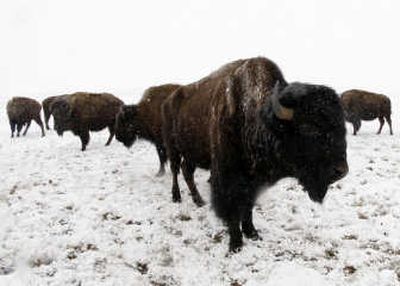The other red meat

MONUMENT, Colo. – Susan Popp was a manager at Hewlett-Packard and her husband was a pilot at the Air Force Academy when they decided to become bison ranchers.
Now the U.S. bison industry is trying to encourage more people – be they veteran cattle ranchers or newcomers like the Popps – to start raising the animals to help meet growing demand nationwide.
“People understand the health benefits of bison. More people are trying it,” said Susan Popp, 42. “It’s not quite so exotic.”
Since they began more than a decade ago, the Popps’ Black Forest Bison ranch boasts a herd of about 60 buffalo, and their store in Colorado Springs is looking for more bison suppliers.
“If things keep going with the demand growing the way it is, we need to get some more people out there raising buffalo,” said Dave Carter, executive director of the Denver-based National Bison Association.
The industry, which touts the meat as a healthier, leaner alternative to beef, is offering an online “Bison 101” course, evangelizing the benefits of bison to lenders and expanding mentoring opportunities for new ranchers.
But it may be a tough sell right now, as factors that are affecting other meat producers – the cost of land, and rising fuel and feed prices – can be obstacles to starting a bison ranch.
In the past few years, the bison association has built demand among customers looking for locally supplied, lower-fat alternatives to beef, and more top chefs are starting to serve bison. Largely wild, bison can calve on their own and aren’t regularly injected with antibiotics or hormones. They also do well in extreme climates.
Today there are bison producers in all 50 states, with about 4,000 private ranches raising roughly 232,000 animals. But the 46,195 bison processed through USDA-inspected facilities last year was dwarfed by the estimated 46 million animals processed in the beef industry.
“It’s a tiny part of American agriculture, but bison has been a part of people’s diets on this continent for thousands of years, and there’s a good reason for that,” said Bob Dineen, who founded Rocky Mountain Natural Meats based in Denver.
The trade group estimates up to 70 million bison may have roamed North America centuries ago, but that figure dwindled to about 1,000 in 1900. The industry claims credit for helping the population rebound.
Annual sales at Dineen’s company have tripled, to more than 2 million pounds, over the past five years. Revenues, expected to reach $30 million this year, have grown 10 percent to 20 percent over the past 10 years, said Dineen, who started his company in 1986.
The U.S. Department of Agriculture reported average wholesale prices for prime slaughter bulls at $220.94 in March, up 22 percent from a year earlier, even as slaughter numbers in federally inspected plants rose at about the same rate.
“There’s no guarantees in this world, but we’ve seen this growth steadily and slowly,” Dineen said. “As we enter new marketplaces and get a toehold, it’s staying and continues to grow.”
This isn’t the nation’s first bison boom, though. The industry thrived on sky-high animal prices during a down market for cattle in the late 1990s, but got too big before ranchers had enough customers wanting to eat buffalo. That led to a slump, worsened by years of drought.
The bison association long has been touting the high protein benefits of bison to health-conscious consumers. Dineen said Ted Turner’s Ted’s Montana Grill has made the meat more accessible while spreading the message that, no, bison are not endangered.
Generally, a pound of ground bison can cost twice that of prime ground beef. In Colorado, ground bison retails at up to $7 a pound.
The National Bison Association’s rancher recruiting efforts include an online primer called Bison 101 that gives tips on what age of animals to buy, when to vaccinate, fencing and other pointers.
It also is trying to inform lenders about the industry’s fortunes, saying bison meat sales reached $239 million at the retail and restaurant level in 2006. Ultimately, it hopes to formalize the mentoring that industry veterans traditionally have offered newcomers, whether their backgrounds are in livestock, crops or something else entirely, Carter said.
Bison graze grassland but have their diets supplemented when food is scarce, particularly in winter. In recent years, both the bison and beef industries have seen feed costs rise.
The Popps get by with the help of outside income. Susan Popp still works at H-P, and Peter Popp is an airline pilot instructor. Susan said they have no regrets about starting a ranch.
“My husband and I, you talk about life dreams. That was something we both wanted to do,” she said. “It’s just beautiful. When you work full days and life gets to you, you come out here, you look at the way they run around … It just makes my heart sing.”